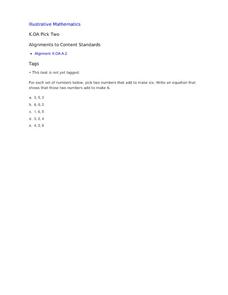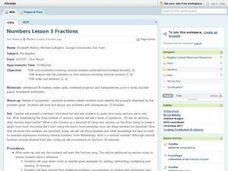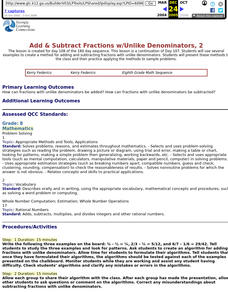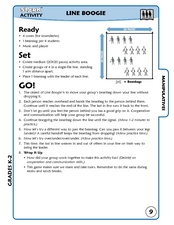EngageNY
Applying the Properties of Operations to Add and Subtract Rational Numbers 1
Apply properties of operations to work with mixed numbers. The first of two lesson plans that focus on properties of operations works with mixed numbers and converting opposites of sums. Pupils work with properties of operations to break...
Illustrative Mathematics
Pick Two
Learning to break apart numbers into smaller pairs is a critical step young mathematicians take as they develop their number sense. To practice this skill, children are provided with sets of three numbers and are asked to pick the two...
Curated OER
Weathering Rocks
Here is a geology lesson that is sure to get your charges excited. It's all about the process of weathering of rocks. Learners study natural events that can cause rocks to break apart. Some of these events are: ice wedging, plant...
PB Works
Numbers Lesson 3 - Hershey Bar Fractions
Talk about delicious math! Pupils solve problems involving rational numbers and analyze real-life problems to find solutions in a pre-algebra class. They discuss the sections of a Hershey's bar in terms of fractions and decimals before...
Curated OER
Weathering Rocks
Fourth graders investigate what natural events cause rocks to break apart and differentiate between erosion and weathering. They conduct an experiment with plaster of paris to observe why some rocks are hard and others break, and...
Curated OER
Add & Subtract Fractions w/Unlike Denominators, 2
Young scholars use several examples to create a method for adding and subtracting fractions with unlike denominators. They present these methods to the class and then practice applying methods to sample problems.
Nuffield Foundation
Enzyme-Catalysed Synthesis
Enzymes: not just for breaking chemicals apart. Young biologists perform an experiment on potatoes. They first remove starch from potato extract. They then add the resulting liquid to samples of glucose-1-phosphate, glucose, maltose, and...
Curated OER
The Real Cost of College
How do people pay for college? Learners explore the concept of paying for college, they discuss possible ways to pay for college, research the cost of colleges, room and board, and other college living expenses.
Curated OER
Skirmish Ball
Build character while playing a fun game. The class practices throwing and catching in this game, which is based on honesty and team work. Take a look at this lesson and see if your class is up to the task.
Curated OER
Digestive System, a Kinesthetic Lesson
Young scholars actively act out an aspect of the digestive tract on two parallel strips of tape on the floor 3-4 feet apart and width of classroom which represent the digestive tract.
Curated OER
Electrical Circuits
Students compare series and parallel circuits. In this electricity and circuits lesson, students roleplay as a "wire" passing an energy ball to demonstrate how a series circuit works and how the circuit can be broken. Students construct...
Curated OER
Expressing Likes and Dislikes
Students identify slang words that they would use in a conversation. They practice expressing their likes and dislikes in speech and written form. They complete worksheets and discuss them to end the lesson.
Pennsylvania Department of Education
Adding and Subtracting Three-Digit Numbers by Jumping
Second graders use data to graph information and draw conclusions. In this instructional activity on data analysis, 2nd graders practice gathering, sorting, comparing, and graphing data. Students differentiate data that can and cannot...
Curated OER
Hang in There
Students view a video clip about bridges. They examine the cables that stablize the Golden Gate Bridge. They relate this concept to elevators.
Curated OER
Line Boogie
Young scholars complete an activity to improve their spatial awareness and loco-motor skills. In this spatial and loco-motor skills lesson, students pass a beanbag down the line of young scholars.
Curated OER
Let Us Bond Together
Fourth graders paricipate in a demonstration about bond strengths and bond types.
Curated OER
Chemical Reactions With Vinegar
Second graders observe chemical reactions. In this scientific inquiry lesson plan, 2nd graders determine whether vinegar creates a chemical reaction by observing two different experiments. A list of 7 supplies is included. In addition,...
















